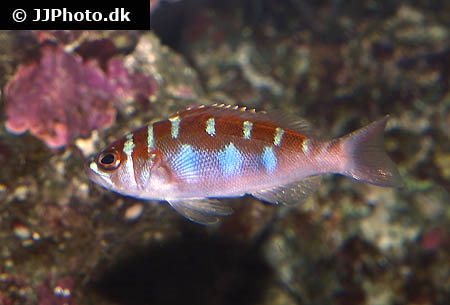Serranus tortugarum

| Latin name | Serranus tortugarum - Longley, 1935 |
|---|---|
| Local name | Chalk bass |
| Family | Serranidae - Serranus |
| Origin | The Mexican Golf, West Atlantic |
| Max length | 8 cm (3.1") |
| Minimum volume |
300 l (79 gal) |
|---|---|
| Hardiness |
Hardy |
| Suitable for aquarium |
Suitable with care |
| Reef safe |
Always reef safe |
| Aggressiveness | Docile |
| Recommended |
Small crustaceans (Krill, mysis, artemia...) Zooplankton (Cyclops, pods...) |
|---|
This species must be fed with an appropriately varied diet.
This species needs good hiding places, for example, between live rocks.
This species thrives best if it is kept in a group of five or more individuals.
This species is very shy and docile, so one should be careful when keeping it with more aggressive fish.
Serranus (Dwarf Seabasses) are a family of pretty predatory fish which are suitable to tank life.
They will eat small fish and crustaceans which can be swallowed, but are otherwise not a threat to the other animals in the aquarium.
Some species will be aggressive towards the more docile fish, but most are fairly peaceful.
They are easy to feed and do not require live food, so a varied diet of frozen fish, crustaceans and the like is sufficient.
Needs to be fed once a day.
The Sea Bass family (Serranidae) spans a broad spectrum with regards to how suitable they are to aquaria, as some are best suited to specialist or larger aquaria, while other are often seen in reef aquaria.
Below are described the five subfamilies one sees most often in aquaria. There are however other species one can also keep under the right circumstances, but these are for the most, large predatory fish.
Anthias (Anthiinae)
The Anthias species spans over many different genera, but the most common is the Pseudanthias genus. They mostly have an attractive orange or pink shade.
They are generally all reef safe and peaceful.
There is however a large difference to their food requirements, some species demand constant feeding, whereas others can get used to being fed once a day.
The easiest species are the following: P. bartelettorum, Anthias, Luzonichthys, Nemanthias, Odontanthias, Pseudanthias, Sacura and Serranocirrhitus
Liopropomatinae
This subfamily encompasses some of the smallest fish in the Serranidae family, they can be very colourful but shy. The Liopropoma genus encompasses many species which are suitable for aquaria, however they normally thrive best in a very peaceful- or nano aquarium.
Grouper (Epinephelinae)
These fish grow typically too large for most home aquaria. There are however some species that do lend themselves to the slightly bigger domestic aquarium. Several of the species look very impressive and often have a interesting personality, and they often recognize the aquarist and will become tame over time.
Groupers are predatory fish and eat everything they can swallow; fish, crabs, shrimps and sometimes other invertebrates. Like most large predatory fish they excrete a lot of nutrients to the water, so one therefore needs a good filter system.
Groupers include among others the following genera: Aethaloperca, Cephalopholis, Chromileptes, Epinephelus, Paranthias and Pogonoperca
Soapfishes (Grammistinae)
These fish are like the Groupers predatory fish, but they do not typically, grow so large. They are relatively hardy, but some of the species demand a thorough preperation if one wants to be successful.
Soapfishes are generally very shy and will often hide under an overhang during the day, and hunt at night.
Soapfishes include among others the genera: Grammistes
Serraninae
The most common genera in captivity is Dwarf Seabasses (Serranus) and Hamlets (Hypoplectrus).
See the description of the individual genera below.
| Aquarium trade | Yes |
|---|---|
| Distribution | Western Atlantic: southern Florida (USA), Bahamas, Honduras and Virgin Islands; probably widespread in Caribbean reef areas. Including Antilles (Ref. 26938). |
| English common names |
Chalk bass |
Edward A. Jackson. 2011. The Atlantic Chalk Bass Serranus tortugarum - Tropical Fish Hobbyist Magazine - (English)
Scott W. Michael. 2001. Reef Fishes volume 1 - TFH Publications / Microcosm Ltd. - (English)
2009. Serranus baldwini - Tropical Fish Hobbyist Magazine - (English)
Edward A. Jackson. 2011. The Atlantic Chalk Bass Serranus tortugarum - Tropical Fish Hobbyist Magazine - (English)
Bob Fenner. The Basses, Family Serranidae - Wet Web Media - (English)

